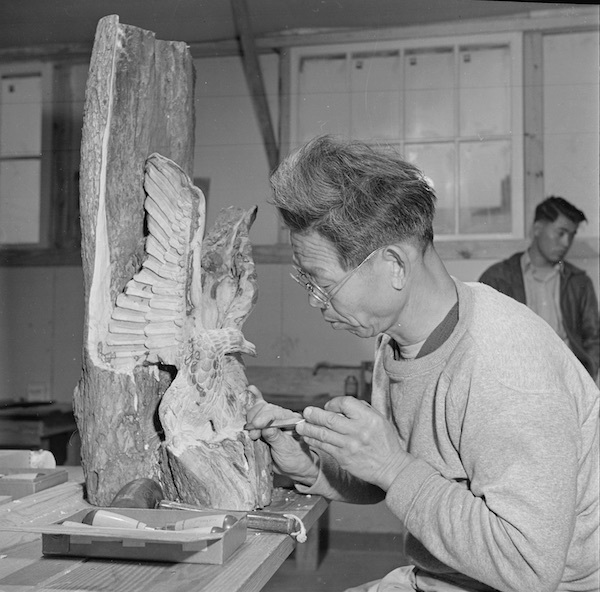Artistry Within Camps
Similar to how Isamu Noguchi created works inspired by his experiences in internment, many other civilians at different camps were also driven to do the same. The main difference between the two is that these civilian artists instead made these pieces actively within the confines of their camp during their internment. An interesting phenomenon is how humans may react to trauma by creating art, illustrated by the many other internment camps that produced victims who created art to cope with their experiences in their walls. This phenomenon in such a context was partly due to art classes being quite common throughout the camps, so much so that “Nearly every camp had some form of art school” (Schultz, 23). The pieces created were mainly made from materials found at or around the camps and were often done so to detract from the trauma faced in such harsh conditions. Delphine Hirasuna argues that “The things they made from scrap and found materials are testaments to their perseverance, their resourcefulness, their spirit and humanity.” Such pieces were typically clothing items, paintings, drawings, postcards, wood and metal sculptures, teapots, and pins.
Through such pieces being created even in harsh, foreign conditions, the idea that art has a role in placemaking and identity can be seen. This is backed by Kristine Kuramitsu in her study of how identity is shaped by art, specifically during Japanese internment. She states that “When agency was stripped from Japanese Americans during the war, one of the few ways left for the internees to articulate their identities was artistic expression.” (Kuramitsu, 621).
This idea that humans can be deeply impacted by their environment and in turn be compelled to create art is not a new one. It is widely accepted that humans create art as a means of placemaking, as explained by former Poston victim Toshio Yatsushiro in reference to why the other victims needed art: “...human beings possess an advanced form of communication, namely language, and the capacity and, in many respects, propensity to think in abstract terms and to create complex ideas, customs, institutions, and material artifacts.” (Yatsushiro, 112-113). This shows that human beings are incredibly complex due to their ability to communicate and create and that this abstractness may take the shape of being drawn to create art. Needing to communicate amongst one another and create their own works or ways of living are simply another facet of the human experience. This facet, as has been studied, does not disappear during traumatic circumstances but instead intensifies and spreads. In this context, it is through their art that this facet may be studied.


